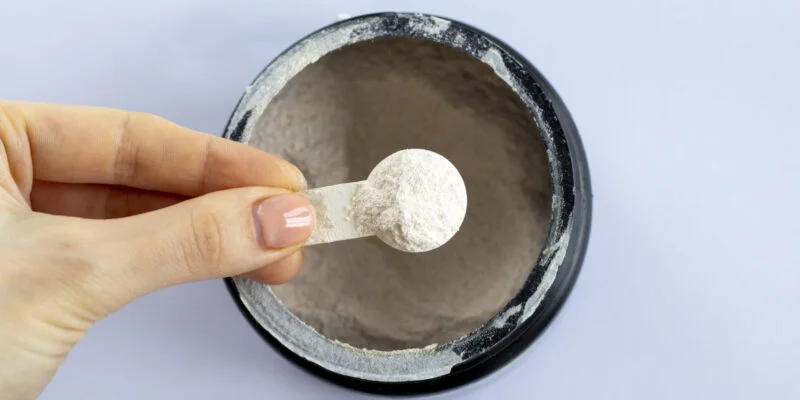New testing finds evidence of “forever chemicals” in 9 popular electrolyte products.
Nine electrolyte products have detectable levels of total fluorine, an indicator of the group of chemicals known as PFAS, according to a new report from Mamavation.
Partnering with EHN.org, the environmental
wellness blog and community had 40 electrolyte products (from 30 brands) tested
by a U.S. Environmental Protection Agency-certified lab and found levels of
total fluorine ranging from 10 parts per million, or ppm, to 105 ppm in nine of
them.
Fluorine is a strong indicator of “forever chemicals”—
which have been linked to everything from cancer to birth defects to lower
vaccine effectiveness. The testing also indicated the presence of fluoride in
the nine products, which is often added to municipal water for oral health but
has been linked to developmental problems in
children.
EHN.org partially funded the testing and Pete Myers, chief scientist of Environmental Health Sciences, which publishes Environmental Health News, reviewed the findings.
The report builds EHN.org
and Mamavation’s growing library of consumer
products tested for evidence of PFAS, including products such as contact lenses, pasta and tomato sauces, sports bras, tampons and dental floss.
While many are aware of PFAS pollution in water, the testing finds that we’re also exposed by the things we wear or eat. You can explore the reporting, "PFAS on our shelves and in our bodies," here.
Many people take electrolytes to maintain
hydration, and balance the body’s levels of salts and minerals as well as the
pressure inside of our cells and the pH balance in our blood — all of which
keep nerves, the heart and muscles functioning properly. However, it seems that
some people may be unknowingly dosing themselves with forever chemicals.
Linda S. Birnbaum, scientist emeritus and
former director of the National Institute of Environmental Health Sciences and
National Toxicology Program and scholar at residence at Duke University, told
Mamavation the new findings are concerning because “for many people,
electrolytes are taken daily.”
“Therefore, it’s very important to avoid
electrolyte products with an indication of PFAS “forever chemicals” based on
potential health impacts, especially for pregnant women and children,” she
added.
Problem ingredients
Mamavation also found additional ingredients in electrolyte products that have been linked to health impacts, including artificial colors and flavors, food additives, and sucralose.
It’s unclear how or why evidence of PFAS is showing up in electrolytes, however, a past EHN.org investigation found PFAS are often getting into cosmetics, clothes and food even when companies are not intentionally adding the chemicals, due to products used in manufacturing, misidentified raw materials, plastic packaging and other ways.
What brands are PFAS-free?
Nine of the electrolyte products out of 40
sent to the lab had some levels of total fluorine, a marker for PFAS, and
fluoride. Some products were tested more than once and the results varied.
These brands had detectable levels of total
fluorine: Flavcity Electrolyte Drink Mix Grape Powdered Drink (65 ppm on first
test, and 17 ppm on second test), Nuun Hydration Sport Tropical (18 ppm),
PaleoValley Essential Electrolytes Watermelon Flavor (55 ppm on first test, and
47 ppm on second test), Plexus Hydrate Natural Blueberry Acai Flavor (17 ppm on
first test and 10 ppm on second test), Signature Care Electrolyte Powder
Variety Pack (13 ppm) and Total Hydration Keto Electrolytes Capsules (105 ppm).
Mamvation also highlighted electrolyte
products that were both free from PFAS evidence and did not contain harmful
ingredients. Some of these brands include Skratch Labs Sport Hydration Drink
Mix with Oranges, Ultima Replenisher Hydration Electrolyte Powder, Keto K1000
Electrolyte Powder Watermelon, Earthley Wellness Electrolyte Powder and others.
"Those nine out of 40 contaminated
products is a lot and leads me to the conclusion that producers of PFAS-free
electrolytes should, as a public service, begin labeling their products as
‘PFAS-free,' Terrence Collins, Teresa Heinz professor of green chemistry &
director of the Institute for Green Sciences at Carnegie Mellon University,
told Mamavation.
See the full report at Mamavation.
The testing is part of an ongoing effort by
Mamavation and EHN.org to identify PFAS in common consumer products. Follow our
PFAS testing project with Mamavationat the series landing page.
Want to know more about PFAS? Check out
our comprehensive guide.
